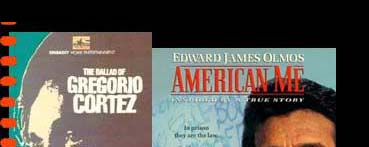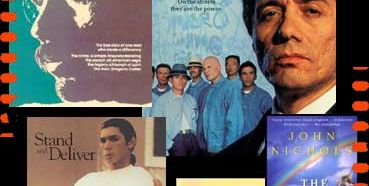NOTES
AND REFERENCES
8.In
1996, I exchanged emails with the late Gene Siskel and Roger Ebert about
this labeling. Siskel had referred to American Latin-theme films-A
Walk in the Clouds, Mi Familia, and Caught-as "Latin
American films." Gene graciously replied: "Thanks for your
hyperbolic response to what you accurately guessed was a slip of the
lip. Yes, I do know the difference between Latino and Latin American.
And you were right to gently chastise Roger for allowing the slip to
occur in his presence." Email, October 23, 1996. Gene Siskel's
intelligence and humor is still missed, although he has a worthy successor
in Richard Roeper.
9.Inclusion
of foreign films in these events might actually be detrimental to their
chances of getting U.S. distribution. Some distributors might assume
since they are in a "Latino" film festival that they wouldn't
appeal to general audiences.
10.Except
in New Mexico where many Spanish-surnamed residents fantasize that they
are direct descendants of the 16th century conquistadores and
insist on thinking of themselves as "Spanish" to differentiate
themselves from Mexicans whom they think are all Indians. In 1998, at
the University of New Mexico during a screening of the Mexican film
Cabeza de Vaca with the director, Nicolás Echevarría
present, an elderly gentleman monopolized the post-screening discussion
claiming he was a direct descendant of Alvar Núñez Cabeza
de Vaca who in 1557 died childless in Seville.
The state of New Mexico, with
a population of about a million and a half with approximately 40% being
Hispanic, through its media persistently exaggerates its national and
even international political, historical, and cultural significance
in Hispanic matters, occasionally successfully promoting itself. For
instance in the late 1990s, a group of New Mexico Hispanic politicians
and community leaders decided the state needed a "Cultural Center."
Named the National (to facilitate fundraising) Hispanic Cultural Center
of New Mexico (giving the impression that there's a whole series of
such facilities in the other states), the $34 million facility was inaugurated
in October 2000 in Albuquerque. Republican Sen. Pete Domenici of New
Mexico enthusiastically declared that people from "all over the
world" would come to the facility to learn about "Hispanic
culture." Funds were raised from large corporations such as Intel,
Disney, and Wells Fargo. Its organizers convinced the Spanish government
to open a small branch of the Cervantes Institute (which brought Crown
Prince Felipe de Borbón for the inauguration).
Whatever attention the Center received
from the Spanish government was likely due to the promotional activities
of U.S. Ambassador to Spain Edward Romero, appointed by the Clinton
administration. A prominent New Mexico businessman and contributor to
the state Democratic Party, Romero arrived to take over his post in
Madrid touting an "ancestor" who left Spain in the 1580s and
was among the first settlers of New Mexico in 1598. Whether any of the
numerous other Romeros in New Mexico (including several politicans and
a boxer) and the United States shared this impressive ancestry, the
Ambassador did not say. As of 2002, the lavish facility, built mostly
with taxpayers' money and which is part of the New Mexico state museum
system, was having trouble attracting visitors. It is also located in
an economically depressed area of Albuquerque, which is discouraging
to visitors. The NHCCofNM generally mounts art exhibits of local and
national artists and screens Mexican and Spanish films, often without
subtitles which also discourages attendance.
In the spring of 2002, Tom Chavez, retired
director of the Museum of New Mexico in Santa Fe, was appointed director
of the Center. He promised to clarify its mission and raise $2 million
to complete a Performing Arts Center. He stated his first task is to
define what "Hispanic culture" is and what aspect of it the
Center is showcasing. Incidentally, the term "Latino" is generally
not favored in New Mexico where "Hispanic" is the label of
preference.
11.CARRO,
Nelson, "Edward James Olmos: un mexicano en Hollywood, Dicine,
November 1992, p. 21. The title of the article is misleading, because
Olmos is American and not Mexican.












